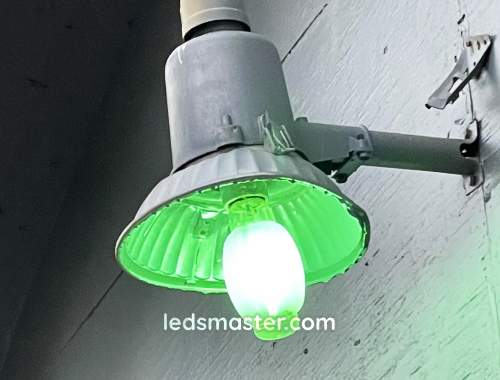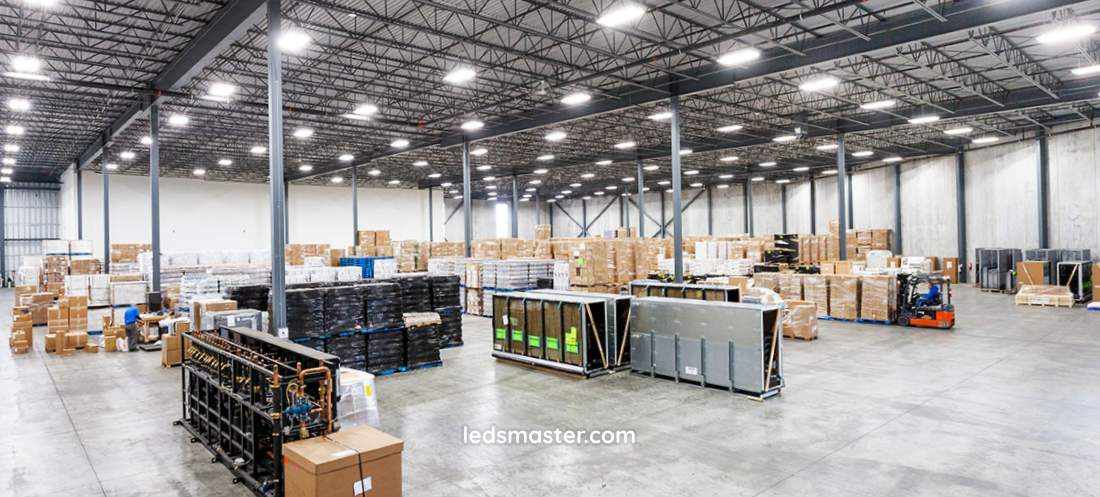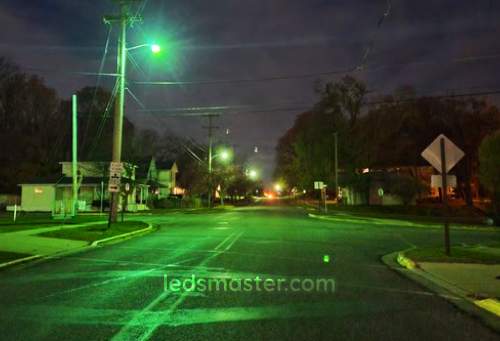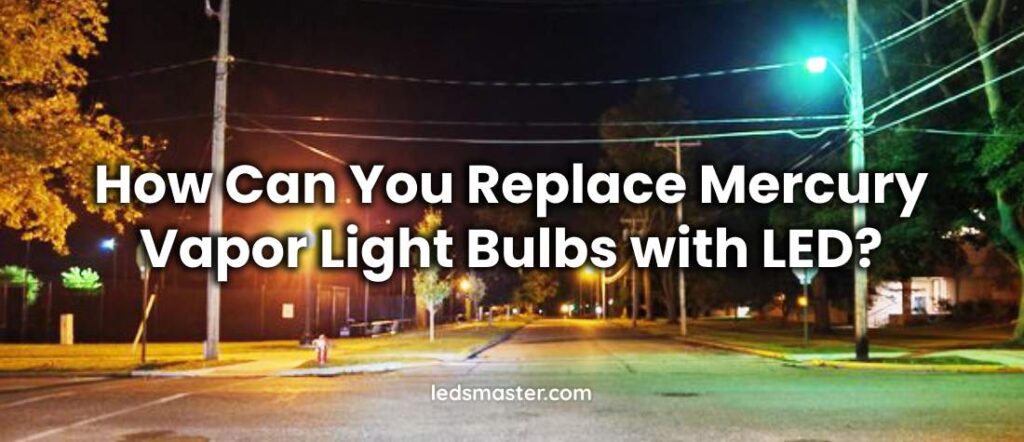Replacing mercury vapor light bulbs with LED lighting is a practical decision for many businesses and property owners looking to modernize their lighting systems. LED lights offer numerous benefits over traditional mercury vapor lamps, including increased energy efficiency, longer lifespan, and reduced environmental impact. This guide will walk you through the process of replacing mercury vapor bulbs with LED lighting, highlighting the power equivalents and other key considerations.
Table of Contents
ToggleUnderstanding Mercury Vapor and LED Lighting
Mercury Vapor Lighting
 Mercury vapor lamps are a type of high-intensity discharge (HID) lighting that have been commonly used in outdoor and industrial applications. They produce light by passing an electric current through mercury vapor, which then emits light. Typically, these lamps come in various wattages, with common ones being 175W, 250W, and 400W. However, they have several downsides, including lower energy efficiency and a relatively short lifespan compared to modern lighting options.
Mercury vapor lamps are a type of high-intensity discharge (HID) lighting that have been commonly used in outdoor and industrial applications. They produce light by passing an electric current through mercury vapor, which then emits light. Typically, these lamps come in various wattages, with common ones being 175W, 250W, and 400W. However, they have several downsides, including lower energy efficiency and a relatively short lifespan compared to modern lighting options.
LED Lighting
Light Emitting Diodes (LEDs) are a more recent innovation in lighting technology. Unlike traditional lamps, LEDs produce light through electroluminescence, which is a process that occurs when an electric current passes through a semiconductor material. LEDs are available in a range of power levels and offer a significant improvement in energy efficiency and lifespan over mercury vapor lamps.
Power Equivalents: LEDs vs. Mercury Vapor
One of the most compelling reasons to switch from mercury vapor to LED lighting is the dramatic difference in power consumption. For example, a 100W LED light can provide illumination comparable to that of a 400W mercury vapor bulb. This is due to LEDs’ higher efficiency in converting electrical energy into light.
Energy Efficiency
The energy efficiency of LED lights is a key factor in their appeal. LEDs can produce the same amount of light (measured in lumens) as traditional mercury vapor bulbs while consuming much less power. For instance, a 100W LED can typically emit between 10,000 to 12,000 lumens, which is comparable to the light output of a 400W mercury vapor lamp. This efficiency translates to significant energy savings and lower electricity bills.
Lifespan Comparison
Another crucial aspect to consider is the lifespan of the lighting. Mercury vapor lamps generally have a lifespan of about 24,000 to 30,000 hours. In contrast, LEDs can last up to 100,000 hours or more, depending on the quality of the fixture and usage conditions. This extended lifespan reduces the frequency of replacements and maintenance, further enhancing the cost-effectiveness of LEDs.
The Benefits of Switching to LED

Cost Savings
Switching to LED lighting from mercury vapor lamps can lead to substantial cost savings. The reduction in power consumption directly lowers energy bills. Additionally, the longer lifespan of LEDs means fewer replacement costs and less maintenance. Although the initial investment for LED fixtures may be higher, the long-term savings often justify the expenditure.
Environmental Impact
Mercury vapor lamps contain mercury, a hazardous substance that can be harmful to both human health and the environment. Proper disposal of these lamps is essential to prevent mercury contamination. In contrast, LEDs do not contain mercury and are more environmentally friendly. By switching to LEDs, you can contribute to reducing the environmental impact and promote a safer, cleaner lighting solution.
Improved Lighting Quality
LED lighting offers improved quality compared to mercury vapor lamps. LEDs provide consistent, high-quality illumination with better color rendering and less flicker. This can enhance visibility and overall safety in various applications, from street lighting to industrial settings. Additionally, LEDs come in a variety of color temperatures, allowing you to choose the right lighting for specific needs and preferences.
Steps to Replace Mercury Vapor Bulbs with LED
Assess Your Current Lighting System
 Before initiating the replacement process, it is crucial to thoroughly evaluate your existing lighting system. Begin by identifying the wattage and type of mercury vapor lamps currently in use. Take note of the number of fixtures that need replacement and the layout of these fixtures within the space. This assessment will provide a clear picture of your current setup and assist in determining the requirements for your new LED system.
Before initiating the replacement process, it is crucial to thoroughly evaluate your existing lighting system. Begin by identifying the wattage and type of mercury vapor lamps currently in use. Take note of the number of fixtures that need replacement and the layout of these fixtures within the space. This assessment will provide a clear picture of your current setup and assist in determining the requirements for your new LED system.
Accurate calculation of the total wattage and lumens of your existing system is essential. This information will guide you in selecting LED fixtures that match or exceed the performance of your current mercury vapor lights. Assessing the brightness levels and coverage areas provided by the existing lamps ensures that your new LED lighting will deliver equivalent or improved illumination. Additionally, check for any compatibility issues. Determine whether your existing fixtures can be retrofitted with LED bulbs or if they will require modifications. Some fixtures may need specific adapters or conversion kits, while others might necessitate a complete replacement.
Select the Right LED Replacement
Selecting the appropriate LED fixtures is a critical step in ensuring a successful transition. Focus on choosing LED fixtures that provide comparable or superior performance to your current mercury vapor lights. Begin by evaluating the lumens output of the LED fixtures. Ensure that they deliver the same or higher lumens output to maintain adequate illumination levels in your space.
Color temperature is another important consideration. LED lights are available in a range of color temperatures, from warm white to cool white. Choose a color temperature that aligns with the desired ambiance and functionality of your lighting. Additionally, pay attention to the beam angle of the LED fixtures. This will affect the distribution and coverage of light, so select fixtures with a beam angle that matches or improves upon that of your existing fixtures.
Compatibility with your existing lighting infrastructure is also essential. If you are retrofitting, ensure that the LED bulbs or conversion kits fit properly in your current fixtures. For new installations, verify that the fixtures are compatible with your electrical system and mounting requirements. This will help avoid any potential issues during the installation process.
Install LED Fixtures
Once you have selected the appropriate LED fixtures, follow the manufacturer’s instructions carefully during installation. This process typically involves wiring the fixtures to the power source and securely mounting them in place. For retrofitting, adhere to the guidelines for installing LED bulbs or conversion kits into your existing fixtures.
Ensure that the fixtures are mounted securely and all electrical connections are correct to prevent safety hazards and operational issues. Proper installation is crucial for achieving optimal performance from your new LED system. After installation, test the LED fixtures to confirm they are functioning correctly. Check for any issues such as flickering or insufficient lighting and make necessary adjustments.
Dispose of Mercury Vapor Lamps Properly
Proper disposal of mercury vapor lamps is essential to prevent environmental contamination. These lamps contain hazardous materials that require careful handling. Follow local regulations and guidelines for hazardous waste disposal to ensure that the old bulbs are managed and recycled safely. Many areas have designated facilities or services for the disposal of such materials, so be sure to utilize these resources to comply with environmental regulations.
Monitor and Maintain
After the installation of your new LED lighting system, it is important to monitor its performance regularly. Periodic inspections will help you identify and address any potential issues early on. While LED systems generally require minimal maintenance, keeping an eye on their performance will ensure that they continue to function optimally and provide consistent lighting quality.
Conclusion
Replacing mercury vapor light bulbs with LED lighting is a smart move for improving energy efficiency, reducing operational costs, and enhancing environmental sustainability. By understanding the power equivalents, lifespan, and benefits of LEDs, you can make an informed decision and enjoy the advantages of modern lighting technology. Following the steps outlined in this guide will help ensure a smooth transition to LED lighting and contribute to a brighter, more efficient future.

